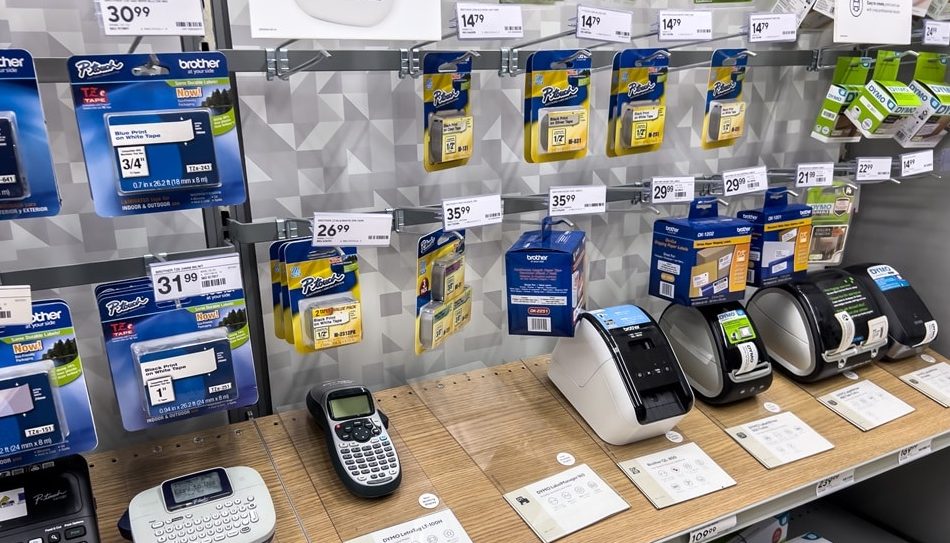Label printer tapes are an essential tool in various industries and homes. Whether you’re labeling products, organizing files, or creating signs, these tapes are valuable for keeping things neat and easily identifiable.
However, to ensure they last a long time and perform well, proper storage and maintenance are key.
This article will guide you through everything you need to know about how to store and maintain your label printer tapes so that they stay in excellent condition for as long as possible.
Understanding Label Printer Tapes
Before diving into the specifics of storage and maintenance, it’s important to understand what label printer tapes are. Label printer tapes are adhesive-backed strips designed to be printed on by a label maker or a label printer. These tapes come in various sizes, colors, and materials, including plastic, paper, and vinyl.
Each type of tape has its own unique characteristics, and the choice of tape depends on the specific use. For example, vinyl tapes are great for outdoor labeling as they are resistant to weather conditions, while paper tapes may be suitable for indoor use and office settings.
Common Uses of Label Printer Tapes
Label printer tapes are versatile and used for many purposes, such as:
- Organizing office supplies and files
- Labeling shelves in warehouses
- Marking cables and wires
- Labeling personal items like lunch boxes or water bottles
- Creating custom signs for home or work
- Identifying products or inventory items in retail settings
Now that we know how useful label tapes are, it’s essential to make sure they last as long as possible. Proper care and storage play a crucial role in preserving their quality.
Importance of Proper Storage
Label printer tapes are made of materials that can degrade over time if not stored correctly. Factors like heat, humidity, and sunlight can affect the adhesive strength, print quality, and overall durability of the tape. Proper storage not only extends the life of the tapes but also ensures they work efficiently when you need them.
Let’s explore how to store these tapes properly to avoid unnecessary wear and tear.
Need Career Advice? Get employment skills advice at all levels of your career
1. Store in a Cool, Dry Place
The best way to store label printer tapes is to keep them in a cool, dry place. High temperatures can cause the adhesive to become too sticky or, in some cases, lose its stickiness. Humidity can also damage the adhesive and the printed text on the tape, making it less durable over time.
Find a location in your home or office that is away from direct sunlight and heat sources like heaters or radiators. Ideally, a room with controlled temperature and low humidity is perfect for storing label printer tapes. If possible, store them in a drawer, cupboard, or cabinet to keep them out of the light.
2. Avoid Direct Sunlight
Sunlight contains UV rays, which can fade the print on label tapes and weaken the adhesive. Exposure to direct sunlight can also cause the tape to become brittle over time, making it more prone to breaking or cracking. To ensure the longevity of your label printer tapes, always keep them away from windows or areas where they could be exposed to sunlight.
3. Keep Tapes in Original Packaging
Label printer tapes usually come in sealed packaging that helps protect them from dust, moisture, and other environmental factors. If you’re not using the tape immediately, it’s a good idea to keep it in its original packaging until you need it. The packaging is designed to preserve the quality of the tape and prevent it from being damaged while in storage.
If the original packaging is damaged or lost, you can use a zip-lock bag or an airtight container to store the tapes. This will help keep out dust and moisture, ensuring the tapes stay in good condition.
4. Store Tapes Vertically
Another useful tip for storing label printer tapes is to store them vertically, rather than laying them flat. This can help prevent the adhesive from settling unevenly, which can sometimes happen if tapes are stored horizontally for extended periods. Vertical storage helps to maintain even pressure on the tape, ensuring the adhesive stays uniform across the roll.
5. Keep Away from Harsh Chemicals
Harsh chemicals, such as cleaning products or solvents, can have a negative impact on label tapes. Chemicals can erode the adhesive or the print on the label, rendering them ineffective. Make sure to store your label tapes in a safe place, away from any chemical cleaners or substances that could cause damage.
Maintenance Tips for Label Printer Tapes
In addition to proper storage, regular maintenance is important for keeping your label printer tapes in top condition. Here are some key maintenance tips:
1. Clean the Label Printer Regularly
Dirt, dust, and debris can build up inside your label printer, affecting the performance of the tape. Regularly clean the printer to ensure smooth operation. Use a soft, lint-free cloth to wipe down the exterior and clean the tape feed area. You can also use compressed air to blow out any dust or particles from inside the printer.
Keeping the printer clean will prevent any smudging or misprints on the label tape and ensure that the tape feeds through the printer smoothly.
2. Use the Right Type of Tape
Not all label tapes are the same, and using the wrong type of tape for your printer can result in poor print quality or damage to the tape itself. Always check the manufacturer’s recommendations for the type of label tape that is compatible with your printer. This ensures that the tape performs optimally and lasts longer.
For instance, some label printers may require thermal label tapes, while others work best with standard adhesive tapes. Using the correct tape helps prevent issues like jamming, misprints, or uneven cutting.
3. Avoid Overusing the Tape Cutter
Most label printers come with a built-in cutter that trims the tape to the desired length. While it may be convenient to use this feature frequently, overusing the cutter can lead to dull blades, which can cause uneven cuts and fraying of the tape edges. To extend the life of the tape and ensure clean cuts, use the cutter only when necessary and avoid cutting excessively small pieces.
4. Store Used Tape Rolls Properly
If you’ve used part of a tape roll but still have some left, it’s important to store the used roll correctly to prevent damage. Rewind the tape neatly back onto the roll and secure it with a small piece of adhesive or a clip to prevent it from unraveling. Store the roll in a dry, cool place, just like you would with a new roll.
This will prevent the adhesive from becoming exposed to air or dust, ensuring that the remaining tape stays in good condition for future use.
5. Label the Storage Container
If you have multiple types of label printer tapes, it’s a good idea to label the storage containers. This makes it easier to find the right type of tape when you need it, without having to open multiple packages. Clear labeling of the storage container also helps prevent unnecessary handling of the tapes, reducing wear and tear.
Choosing the Right Label Tape for Your Needs
Choosing the correct label tape is important for ensuring longevity and durability. Different types of label tapes are designed for specific environments and purposes. Here are some common types and their uses:
- Vinyl Label Tape: Ideal for outdoor use due to its resistance to weather conditions and UV light.
- Plastic Label Tape: Durable and versatile, suitable for both indoor and outdoor use.
- Paper Label Tape: Best for indoor applications like office labeling, where exposure to moisture is minimal.
- Heat-Resistant Label Tape: Designed for environments where high temperatures are present, such as labeling electrical components or machinery.
When selecting label tape, consider the environment where the labels will be used and how long they need to last. For example, if you need labels for outdoor use, vinyl tapes are the best option because they can withstand rain, sunlight, and other weather conditions. On the other hand, if you need temporary labels for indoor use, paper tapes may be more cost-effective.
How to Replace and Install Label Printer Tapes
Properly replacing and installing label printer tapes is another aspect of maintaining them for longevity. Follow these simple steps to replace your label tape efficiently:
- Turn off the printer: Always turn off the printer before replacing the tape to avoid any accidents or malfunctions.
- Open the printer: Locate the tape compartment and carefully open it to remove the old tape roll.
- Insert the new tape: Take the new label tape and insert it into the designated slot, ensuring it’s aligned properly.
- Close the compartment: Once the new tape is in place, close the compartment securely.
- Test the print: Turn on the printer and print a test label to ensure the tape is installed correctly and the print quality is good.
By following these steps, you can ensure that the tape is installed properly and is ready for use without any issues.
Conclusion
Maintaining and storing your label printer tapes correctly is essential for ensuring they last as long as possible. By following these simple guidelines, you can protect your tapes from environmental damage and keep them in good working condition. Always store them in a cool, dry place, avoid direct sunlight, and keep them in their original packaging when possible. Additionally, maintaining your label printer and using the correct tape will help ensure that your labels are of the highest quality.
When taken care of properly, label printer tapes can provide long-lasting service, saving you money and time in the long run. With the right storage and maintenance practices, your label tapes will be ready to use whenever you need them.
For all your labeling needs, choosing the right label tape is also essential. Whether for home, office, or industrial use, taking care of your label tapes ensures they perform at their best every time!




